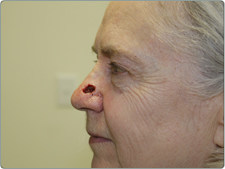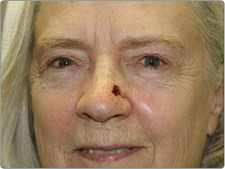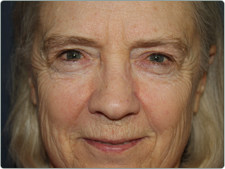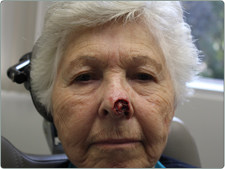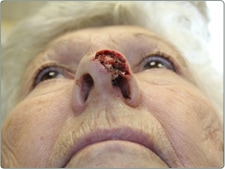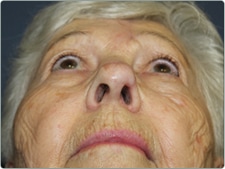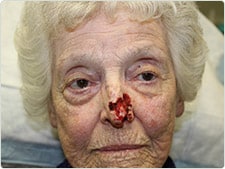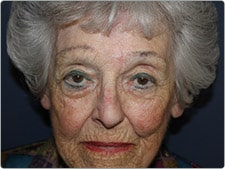Nose Reconstruction
in Torrance, CA
Also serving Palos Verdes & Redondo Beach
Nasal reconstruction surgery is a procedure frequently performed after removing skin cancer on the nose. The reconstructive technique is determined by the size and depth of the defect on the nose. Small defects less than 5mm may be repaired by a primary closure. This means the edges of the wound are sutured together in multiple layers. The wound is then made into an ellipse to allow for a smooth closure after nasal reconstruction.
Defects on the nose that are between 5mm and 15mm may be repaired with local flaps or skin grafts. A local flap is tissue from the nose that is repositioned to fill the defect. Additional incisions are required to create the flap. The following pictures show reconstruction of a nasal wound with a local bilobed flap.
The advantage of a flap procedure for nose reconstruction is that flaps maintain a vascular supply and can be composed of multiple tissue layers, including muscle, fat, and skin. Defects on the nasal tip or alar generally benefit from the replacement of multiple tissue layers. This allows the surgeon to replace exactly the tissue that was removed. In addition, local flaps tend to have a very good color match with the surrounding nasal skin after reconstruction of the nose.
Skin grafts may also be used for defects between 5mm and 15mm, or even larger defects. Skin grafts seem to have their best results on the upper 2/3s of the nose where the skin is thin. Skin grafts only replace skin, and therefore tend to provide relatively thin coverage for nasal reconstruction. Skin grafts will frequently result in a color mismatch with the surrounding nasal skin after nose reconstruction. In addition skin grafts are not generally used in defects with exposed or missing cartilage. These complex defects usually require a flap.
Larger defects may require a pedicled flap such as the forehead flap. Nasal tip or alar defects larger than 15mm usually benefit from forehead flap nose reconstruction. The forehead flap requires two or three stages to complete. In the following case, the nasal tip defect extended down to the nasal tip cartilage and a forehead flap was used to reconstruct the nose. The procedure took two stages.
In this second example, the defect was significantly more complex. In this case, not only was the skin removed, but also the underlying cartilage and internal nasal lining. For this situation, all layers should be reconstructed during surgery on the nose. First, the internal nasal lining was reconstructed with a nasal septal flap, then the cartilage was reconstructed with ear cartilage. Finally, the skin and subcutaneous fat was reconstructed with a forehead flap. This type of nose reconstruction was performed in two stages.
Nose Reconstruction
Nasal Reconstruction Frequently Asked Questions (FAQs)
What Is Nasal Reconstruction Surgery After Skin Cancer Removal?
Skin cancers, most commonly basal and squamous cell carcinoma, may develop on the nose due to prolonged sun exposure. When removed, cancer may leave a visible wound that affects the nose’s shape and function.
Nasal or nose reconstruction is a surgical procedure that repairs and restores the nose after skin cancer removal, trauma, or other conditions that cause tissue loss.
Why Is Nasal Reconstruction Needed After Skin Cancer?
Reconstruction may help:
- Restore the natural shape of the nose
- Improve breathing function (if affected by the surgery)
- Minimize visible scarring
- Enhance overall facial symmetry
Dr. Bray, Jr. offers advanced techniques to precisely rebuild the nose, including skin grafts, local and regional flaps, and cartilage reconstruction.
How Long Does It Take to Heal After Nasal Reconstruction?
Healing times vary based on the complexity of the reconstruction. Most patients experience swelling and bruising that starts to subside over the first couple of weeks. Dr. Bray, Jr. typically removes sutures at around 7-10 days.
Over the first month, the most noticeable swelling decreases. Healing steadily progresses over the coming months and incisions start fading. By the one-year mark, scar tissue softens, and the nose usually settles into its long-term shape.
More complex reconstructions, especially those requiring multiple stages, may extend the healing timeline.
What Type of Anesthesia Is Used for Nasal Reconstruction?
Local anesthesia with or without sedation is common for minor reconstructions, and general anesthesia is more common for extensive surgeries requiring cartilage grafting or multiple stages.
Will My Nose Look Normal After Reconstruction?
Dr. Bray, Jr. is triple board certified by the American Boards of Plastic Surgery, Facial Plastic and Reconstructive Surgery, and Otolaryngology – Head and Neck Surgery.
His patients often achieve significant improvement (check out our before and after images to see real patients and their results.)
Dr. Bray, Jr. uses precise techniques to ensure the reconstructed nose looks as natural as possible and maintains facial harmony. While some scarring is inevitable, many scars fade and become barely noticeable. Patients may achieve significant cosmetic improvement, and the reconstructed nose often resembles its original appearance.
How Is Skin Grafting Different from Flap Surgery?
Both techniques are used in nasal reconstruction, but they’re different.
- Skin Grafting: In skin grafting, Dr. Bray, Jr. uses a thin layer of tissue from another part of the body to restore the nose. It works well for small, superficial defects but may not perfectly match the surrounding skin texture. A skin graft does not have an attached blood supply of its own.
- Flap Surgery: Uses nearby skin, including its blood supply, to cover the nose wound. This technique offers better color and texture match, making it ideal for larger or deeper wounds.
Dr. Bray, Jr. plans your nasal reconstructive technique based on the amount of tissue requiring replacement and other individual factors.
Does Nasal Reconstruction Affect Breathing?
In some cases, nasal reconstruction improves breathing by restoring the nasal structure. If skin cancer removal could compromise breathing, Dr. Bray, Jr. may perform cartilage grafts or other types of structural reinforcement to avoid future issues.
Does Nasal Reconstruction Require Multiple Surgeries?
Some nasal reconstructions require one procedure, while others require multiple stages. Dr. Bray, Jr. often restores smaller defects, especially those less than 5 mm, in one procedure.
Complex reconstructions, including large skin flaps, cartilage grafting, and other structural restorations, may require two or three stages for proper healing and optimal aesthetic outcomes.
When Can I Have Nasal Reconstruction After Mohs Surgery?
In many cases, Dr. Bray, Jr. can perform nasal reconstruction immediately after Mohs surgery.
However, sometimes, you need a brief period between procedures to ensure the wound is clean and ready for closure. Dr. Bray, Jr. will coordinate with your Mohs surgeon to determine the optimal timing.
How Much Does Nasal Reconstruction Surgery Cost?
The cost of nasal reconstruction varies based on:
- The complexity of the procedure
- The reconstruction technique
- Anesthesia fees and facility costs
Contact Dr. Bray, Jr.
Dr. Bray, Jr. is a dedicated, caring surgeon specializing in nasal reconstruction. If you need nasal reconstruction after skin cancer removal, contact our office at 310-326-9400 to schedule a consultation and learn more.

